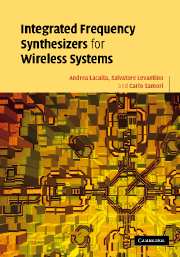2 - Phase-locked loops
Published online by Cambridge University Press: 09 August 2009
Summary
Basics
Introduction
The earliest research on phase-locked loops dates back to 1932, when British researchers developed the homodyne receiver as an alternative to Edwin Armstrong's superheterodyne receiver. The homodyne or synchrodyne system has fewer elements than the superheterodyne system: just a local oscillator, a mixer and an audio amplifier. The local oscillator is tuned to the desired input frequency and its output is multiplied by the input signal, thus producing a replica of the original audio modulation signal.
However, the performance of such a simple receiver was affected by the slight drift of the oscillator frequency. Following the seminal work of a French scientist, [1] an automatic correction signal was introduced, to keep the oscillator signal at the same phase and frequency as the desired signal. Even if the solution fixed the limitations of the homodyne receiver, the application of PLLs remained limited, mainly because of the cost of the circuit.
In TV receivers, the set-up was adapted to synchronize horizontal and vertical sweep oscillators to the transmitted sync pulses, but only in the 1960s did the appearance of monolithic circuits with complete phase-locked loop systems on a chip spur its widespread use.
Since then, a number of books and countless papers have been devoted to PLLs. References [2–15] are some of the most popular books on the topic, [16–19] are collections of classical papers, while [20] and [21] are special issues dedicated to PLLs.
- Type
- Chapter
- Information
- Integrated Frequency Synthesizers for Wireless Systems , pp. 14 - 48Publisher: Cambridge University PressPrint publication year: 2007



